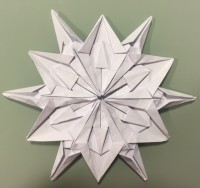Here at Physics World HQ we have seen a lot of origami cropping up in physics over the last few years, be it curved-crease origami, origami robots or even sheets of graphene oxide going for a stroll.
It seems that a growing number of physicists have cottoned on to the fact that origami – and the related art of kirigami, where cuts are allowed – can be very interesting from a physics point of view, with properties that can lead to novel applications over a range of length scales. If you are a member of the Institute of Physics, you can read all about it in “Flat-pack physics”, a feature by science writer Simon Perks published in this month’s edition of Physics World.
As part of some background research for this feature I came across some great origami designs. One in particular – a snowflake – caught my eye and I got in touch with its designer Dennis Walker, who has been a paper folder for about 35 years. Walker very kindly agreed to update his instructions for making the snowflake especially for Physics World. They are now nice and clear and you can find Walker’s updated pattern here (PDF).
As an origami novice I can attest that the pattern is possible to follow albeit challenging (one of my attempts is shown in the photo above). In following the instructions it will help to know that dashed lines represent “valley” folds, where the paper is folded upwards into a “V” shape with a crease at the bottom; and the lines containing alternate dots and dashes represent “mountain” folds, where the crease is at the top and the paper is folded downwards into a “Λ” shape.
To start with you will need a piece of paper in the shape of a hexagon; you can find out how to cut a hexagonal piece of paper here. If you get stuck, do post a comment below describing exactly where you have got to. It may be that I or someone else can chime in to help you become unstuck.
What have snowflakes got to do with physics? Well, I am a physicist who just happens to enjoy puzzles and crafts, and I had a hunch that some of you might enjoy attempting this origami pattern too. But if I had to justify the link then I would point to Caltech physicist Kenneth Libbrecht’s classic Physics World feature “The enigmatic snowflake”, in which he describes the complex physics that governs how ice crystals grow, as he discovered by growing beautiful snowflake specimens in his lab.

Hate to question Einstein, but if what contains universes,(the dark) is infinite, would not time be a sence of recognizable perception and not truly something to exist?